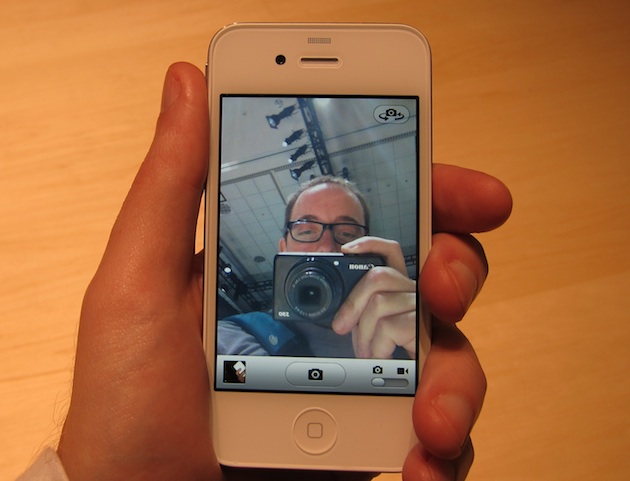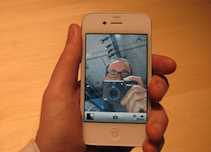
This morning, my colleague Jason Kincaid wrote a very good and very level-headed post about the new iPhone (and the new iOS 4 software) from the perspective of an Android user. I’m going to come at it from the other angle.
Recently, I’ve written my takes on both the Nexus One and the EVO 4G from the perspective of an iPhone lover. Obviously, I don’t have an iPhone 4 yet, and so this isn’t a full review, but after the keynote yesterday we did get some hands-on time with the new device. So I figured I’d write down my initial reaction after playing with the new hardware for about 20 minutes or so. Before I go any further, I’ll save you the suspense: it’s awesome.
The Build
The biggest thing that stands out in my mind one day later is that immediately after I put down the iPhone 4 and went back to my iPhone 3GS, the latter felt kind of like a toy in comparison. Now, I’ve always been a fan of the design of the first iPhone over the iPhone 3G and the iPhone 3GS — that is, I liked the aluminum flat back of the first one more than the plastic backs of the second two. The iPhone 4 is a return to form — literally — but it’s even better now, as the aluminum has been replaced by glass (in either black or white).
As Jason noted, the device feels rock solid in your hand. It is without a doubt the most impressive piece of mobile hardware I’ve ever held. There’s nothing on the device that feels janky. Aside from the backside upgrade, all the external buttons on the device are now improved as well. The iPhone 4 is pretty much identical in weight to the iPhone 3GS, but it’s significantly thinner. This may be a bit hard to notice in your hand as the iPhone 3G/3Gs has the curved back (so you mostly handle the thinner edges), but I have no doubt it will be noticeable in your pocket.

The Screen
When the iPhone 3GS first launched, I wasn’t sure that the boost in speed would be enough to make an upgrade worth it. I was wrong. Once I had an iPhone 3GS and went back to using an iPhone 3G, the latter almost seemed unusable to me. Thanks to the screen on the iPhone 4, this seems likely to be the case as well.
As Steve Jobs joked in the keynote, “once you go Retina Display, you can’t go back.” After just 20 minutes of using it, I’m hooked. As Daring Fireball’s John Gruber noted yesterday, it’s not just that the iPhone 4 has four times the pixels of the earlier iPhones, it’s that much of the distance between the glass you touch and the pixels have been removed as well. It’s subtle things like this — things that most people will never even realize they’re noticing (but they are) — that make Apple, Apple.
With the iPhone 3GS (or any of the other iPhones), if you bring the device close enough to your face, you can see the pixels. With the iPhone 4, you can’t. It’s really not like looking at a computer screen at all. It’s like looking at a picture — or when something on the screen is moving, film.

The Speed
In terms of speed, it’s hard to know what is the new iOS 4 and what is the new hardware, but the device does seem to run a little bit smoother. It’s not noticeably faster in the way that the iPhone 3GS was noticeably faster than the iPhone 3G, but I would attribute this to the fact that there are already rarely any lags in the iPhone 3GS with iPhone OS 3. I suspect some new games that come out may push the new A4 chip though.
The Camera
As has already been noted, FaceTime is brilliant in that it requires absolutely no set-up to work. Yes, it sucks that it’s WiFi-only, but that will change with time. It also would have been brilliant for Apple to get this working with iChat on Macs (as others have also noted), but since it’s supposedly going to be published as an open protocol, that will probably come too.
I can see the new front-facing camera doing wonders for startups like DailyBooth — and yes, maybe even ChatRoutlette.
The key feature of the camera though has to be the ability to shoot HD (720p) video. There’s some debate out there as to whether this will or won’t kill the Flip cam. My reaction is that while the iPhone 4 alone may not, I can’t see how all of these new smartphones gaining this feature (the EVO 4G can do it as well) won’t.

The Android Question
I know that it’s shocking to some of you that I would love this device. Most interesting may be my thoughts on what this means or doesn’t mean for Google’s Android platform.
As you’ve undoubtedly read a lot in recent weeks, Google is making fast gains in terms of the Android software. I was beyond impressed at Google I/O with everything that was shown off. With Android 2.2 (which I have running on the Nexus One), most system speed issues seem to have been resolved. That said, in my view, there is still no Android device that is better than the iPhone 3GS. And so obviously, the iPhone 4 just widens the gap.
The fact of the matter is that while the software may be getting there from a practical perspective, it still lacks the polish of the iPhone OS (now iOS). A number of people (on both the iPhone and Android sides) I’ve spoken with recently agree, but point to Google’s recent hiring of Palm’s design guru Matias Duarte as a sign that this may change. I hope so.
Overall app quality on Android also still lags behind the iPhone. And the fact that you have to use third-party task killing applications to get devices like the EVO 4G to run the way it should, is completely unacceptable from a users’ perspective.
With the iPhone 4, Apple has refined the hell out of their winning combination of hardware plus software. It’s hard to imagine it getting much better in this form factor — and that’s why I think we may see some radically different things next year for iPhone 5 (well, aside from a Verizon version).
The Mac vs. PC debate has often found people using a car analogy to explain things. I keep coming back to that when thinking about iPhone vs. Android. For a long time, iPhone felt like a Lexus while Android was more like a Kia. With recent upgrades, Android has transformed into more of a Honda. But with iPhone 4, the iPhone is now an Aston Martin (it was James Bond, remember).
But the crazy thing is that the iPhone is an Aston Martin with a Honda-price. Meanwhile, Android remains a Honda at a Honda-price — it’s a good deal, but it’s not an iPhone-deal.
In fact, it’s such a good deal that I continue to say that the only thing really holding back the iPhone (in the U.S.) is its carrier, AT&T. Even if you have no problems with AT&T, you have to acknowledge that they’re becoming the big barrier to the iPhone’s potential growth. There are simply always going to be million of users not on AT&T. In fact, there will always been more users not on AT&T than are on it. So Apple needs to move beyond it to keep expanding.
And if they’re the Aston Martin being sold at Honda-prices, when they’re sold at other dealerships (other carriers), they’ll dominate, right? Well it’s not that simple.
The Honda-like price is only thanks to the sweet deal Apple gets from AT&T. Without the deal, Apple would undoubtedly sell the iPhone for more money (to keep up their margins), and it would be a less attractive purchase for people. It’s the same reason why everyone doesn’t buy an Aston Martin (or a Lexus, to be more practical). Would some people still opt for the Honda if it was more customizable? Sure, some would. But most would opt for the nicer machine, all things being equal.
But all things aren’t equal because the iPhone is tied only to AT&T. And all things are unlikely to ever be equal because prices might have to go up if the sweet AT&T exclusive subsidy goes away. But seeing the success Apple has had being at the luxury end of the PC market, I’m not sure how much they’ll ultimately care. But the fact that they seem to now (as evidenced by pointing out their market share vs. Android in keynotes) is interesting.
As Jason noted in his piece (and I have in the past), the fact of the matter remains that a strong rivalry between iPhone and Android is a good thing for us all. Android continues to improve at a healthy pace and they have some features (like Google Voice integration) that it seems unlikely now that Apple will ever get. Meanwhile, Apple continues to improve their hardware/software combination at a rate that it’s not clear that Google (and their OEM partners) will be able to match.
It’s two different approaches. And that makes sense since the two have different motives. At the end of the day, Android exists so that Google can get more people searching — and keep them searching as mobile devices overtake computers. The iPhone exists to be one of the mobile devices that overtakes computers so that Apple can keep selling high-margin machines.
In my view, for most consumers, the iPhone remains the winning argument in the space right now. And the iPhone 4 just extends that.
